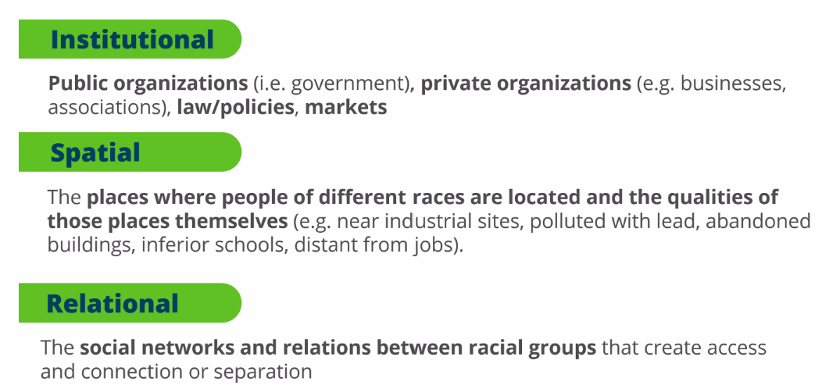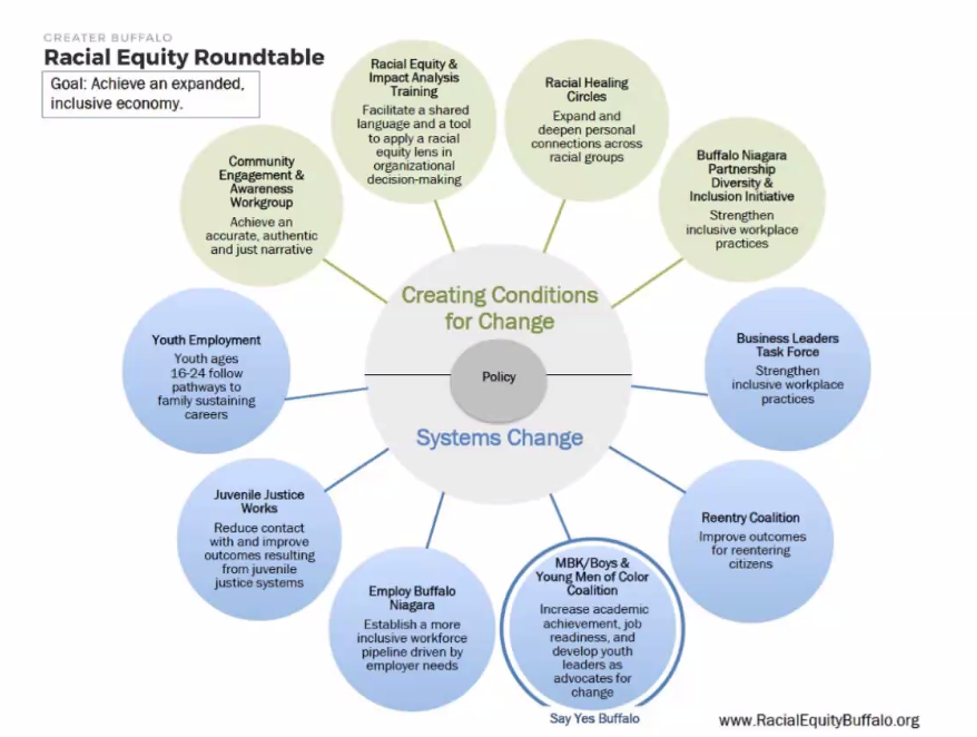In his plenary presentation at the OYF Digital Learning Series on May 27, 2021, ForwardChange President Arnold Chandler described structural racism as composed of three pillars: institutions, places and relationships.

Throughout American history, the mechanisms of exclusion, exploitation and control have operated across these three dimensions to result in inequitable life outcomes for Black, Indigenous and People Color. BIPOC young people are more likely to be disconnected from work and school than their white counterparts, and even when comparing those who have graduated from college, Black, Latinx and Native youth earn 20-25% less income, hold 10-15% as much wealth.
These disparities are inherently tied up in place: where people live continues to predict who will thrive, and BIPOC communities are concentrated in places of diminished resources. As Chandlers cites, Raj Chetty found that the racial gap in intergenerational economic mobility is not explained by single parent families, education or wealth, but by the characteristics of where people live. Around 70% of Black children will live in high poverty neighborhoods during their childhood compared to 6% of white children. At any given time, 27% of Native children live in high poverty neighborhoods. Where people live is no accident. As Chandler said in his September 2020 presentation to the OYF, “there have been no more deliberate decision in American than structure where we live to preserve advantage and disadvantage. Places that Native Americans and African Americans live in were made worse by deliberate policy decisions” that have persisted since long past Jim Crow. His laid out this history in stark detail from 1910 to today.
Monique Miles, Aspen Institute Vice President, responded that because “this history is not known and not understood,” we must confront it directly to embark upon the process of transformation. “Structural racism was created with intentionality. It can be dismantled with intentionality,” she said. As Dr. Gayle Christopher, one of the architects of the W.K. Kellogg Foundation’s Truth, Racial Healing and Transformation initiative told the Opportunity Youth Forum in 2015, “We have to undo and replace a hierarchy of human worth. Our work is to set a motivational intention to create a new model that replaces a hierarchy of human value.”
That is a weighty challenge. Yet it is the transformational work that leaders from across sectors are engaged in through the Buffalo Racial Equity Roundtable. Community Foundation for Greater Buffalo President Clotilde Perez-Bode Dedecker and Senior Director of Racial Equity Initiatives Felicia Beard, Erie County Personnel Commissioner Timothy Hogues and student leader Malik Stubbs joined Miles to unpack this work at the second plenary of this learning session.
Buffalo remains extremely segregated by race and the site of deep racial inequalities. As the region’s overall economy began to significantly improve in the early 2010s after years of decline, leaders from the public, private, philanthropic, and nonprofit sectors came together to consider the business case for centering racial equity in the community’s economic development strategy. Convened by the Community Foundation for Greater Buffalo (CFGB) and supported by the expertise of Dr. Christopher and WKKF, in 2014, prominent leaders from 32 organizations representing public systems, the business community, and faith and community-based organizations launched the Roundtable as a coalition of the willing committed to the goal of an inclusive, expanded economy.
“The first step was to ground the work of the collaborative in data,” CFGB’s Perez-Bode Dedecker explained. In 2016, researchers commissioned by the Roundtable released The Racial Equity Dividend: Buffalo’s Great Opportunity, an important report that mapped the community’s racial equity gaps and made a powerful business case to close these divides: doing so would lead to over $1 billion increased regional GDP annually and $12 billion in wealth for families. This report mirrored Chandler’s analysis of by identifying how institutions, place, and people impact equity in Buffalo, confronting how the history of structural racism explains circumstances today. Adding the economic argument to the moral imperative was compelling. The Roundtable has grown to over 330 organizations as leaders and community members responded to being called in to join the dialogue, stay rooted in data, and focus on changing systems to close these equity gaps.
Over the past 5 years, the work has evolved into the following 10 mutually reinforcing strands:

The two strategies at the top center of the chart above are particularly important in creating the conditions for systems change and transformed policy. The Roundtable has brought a common Racial Equity Impact Analysis and Training to over 130 organizations and 3,200 individuals. Participants are generally senior leaders within their organization. They go through a 12-18 month training cohort, setting them up to train others within the organization, and advance this work internally. Demand for this training has grown as it has spread and become a common language in the community and offers individual organizations and collaborative efforts alike a shared tool for decision making.
In 2018, the Roundtable launched Racial Healing Circles. With the support of the W.K. Kellogg Foundation, vetted practitioners use a train-the-trainer model to prepare leaders like Erie County’s Timothy Hogues to facilitate Healing Circles in community settings. The first two years of the pilot focused on inter-congregational settings, connecting diverse groups, e.g. Baptist and Jewish faith communities. As CFBG’s Felicia Beard said, “the circles were popular and interest grew, so in 2020, the Foundation transitioned their facilitation to a trusted community organization and brought them to the business world.” The events of 2020 catalyzed interest, and the regional chamber of commerce paid to offer the circles to its membership. In 2021, slots for businesses to offer the circles to their employees are booked solid through the end of the year. The Roundtable continues to work with technical assistance providers from the Race Matters Institute to sustain local capacity to engage in this work, and to continue the continuum of convening, training and coaching strategies that support momentum.
Erie County’s Timothy Hogues emphasized the importance of going slow and taking a long-term approach to these strategies. “The foundational racial equity & impact analysis training, and relationship piece need to come first. Healing circles comes next, but those leading these need to be well-prepared and supported by a coaching-feedback loop and community of racial healing practitioners.”
The business community paying for teams to participate in racial healing circles reflects how invested employers are in the racial equity agenda in Buffalo because they see it as authentically connected to economic development strategy. CFGB and the Roundtable emphasized the importance of investing up front in tailoring engagement strategies to them as a specific audience meaningfully connected to the coalition. “Business leaders have a different language,” said Perez-Bode Dedecker. “Early on, we conducted focus groups and interviews with business leaders to determine the language that they felt called them in to do the work. Then we engaged them in learning together, considering best practices from other markets, breaking bread together to build relationships.
”This has led to some hard wins. The Roundtable’s Business Leaders Taskforce brought together 14 major employers, including multinational corporations in sectors like food production, advanced manufacturing and healthcare, who decided to focus on racial equity in their purchasing. After two years of work, analyzing financial data and procurement, these companies doubled their spend going to BIPOC-owned businesses, an additional $100 million.
Employers are also connected to the Roundtable’s work to advance employment outcomes for opportunity youth through the Buffalo Youth Employment Coalition (YEC), which seeks to develop youth as a key source of talent and build and promote culturally competent, equitable work experiences and environments for young adults. This complements the Roundtable’s emphasis in improving secondary and postsecondary educational opportunities and outcomes that Say YES Buffalo has played a key role in driving. Over the next three years, the YEC plans to connect gaps in the youth serving ecosystem and engage young people themselves alongside business leaders and practitioners to launch a multi-sector youth apprenticeship pilot.
The Buffalo Racial Equity Roundtable offers a case study of a cross-sector collaborative for building an inclusive local and regional economy. These leaders have leaned into, not shied away from, an honest and painful assessment of what structural racism looks like in their community, allowing them to imagine and commit to a different future where improved access to opportunity benefits all. While there is much more to do, they have built real momentum – anchored in data, changing systems, and relationships – to dismantle the “spatial division of opportunity, the creation of the geographic haves and have nots,” as Arnold Chandler describes the system we all live in today.
The Aspen Forum for Community Solutions looks forward to uplifting other examples of how place-based collaboration can dismantle the conditions of structural racism in subsequent sessions of our 2021 Opportunity Youth Forum Virtual Learning Series.